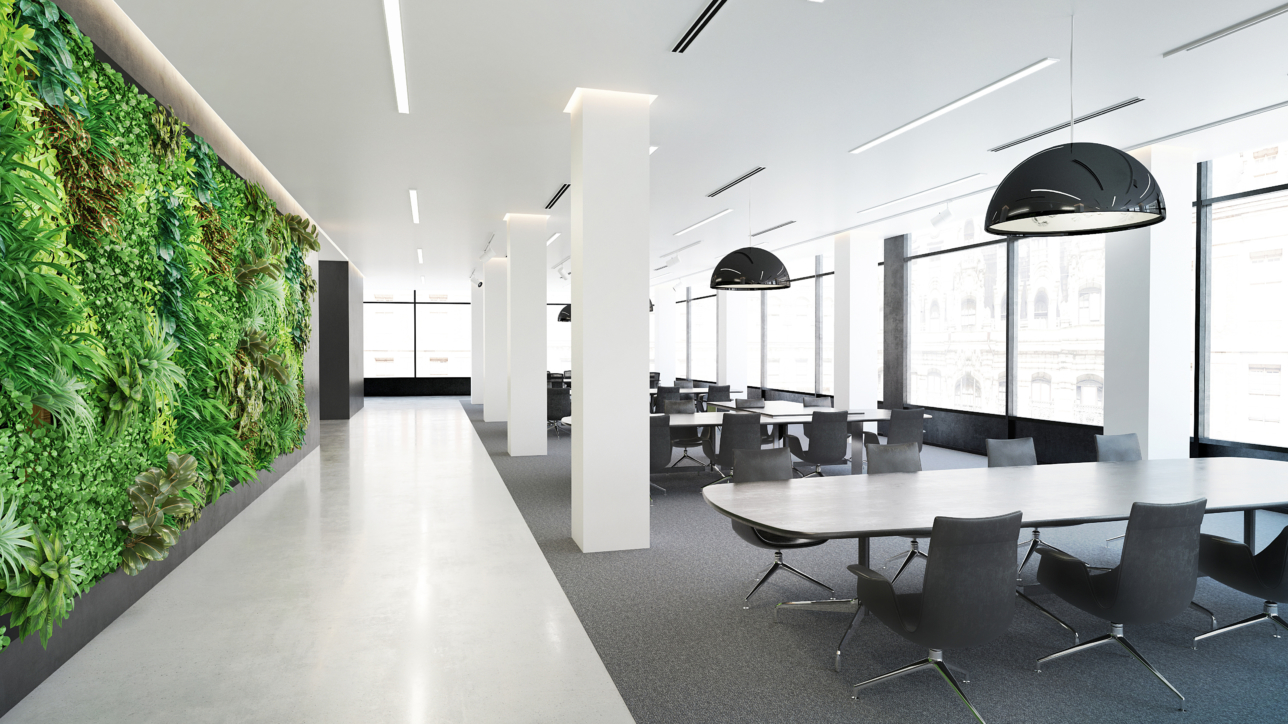The words “office space” can conjure up images of corner offices, open floor space and cubicles. Or, those words could conjure up images of something vastly different, given the changes going on with office spaces. AIR CRE tapped into the expertise of three office design experts to determine the top trends impacting the office space evolution.
1) “Work” and “Desk” aren’t Mutually Exclusive
Employees are no longer tied to their desks. Rather, they are completing tasks at conference tables, on comfortable lobby sofas or seated next to an outdoor courtyard fountain.
One factor driving the trend is technology, which allows employees to plug into any WiFi hotspot. And, according to Joshua Zinder, millennials and those making up Generation Z are another factor. “They’re more comfortable in a social setting, drinking coffee, or elsewhere,” said Zinder, managing partner with JZA+D in Princeton, NJ. “As a result, a lot of companies are asking us to create more amenities spaces, and to create more relaxed atmospheres to attract younger people into the corporate world.”
Speaking of which . . .
2) Amenities Remain Important
“When we think of amenities, we think of space where people go NOT to work,” remarked Shannon Woodcock, Senior Design Strategies and Associate with HLW. Meaning amenities are more than the restaurant down the street. They can include everything from an on-site gym or café, to a dry-cleaning operation in an office building lobby, to a game room near a company’s meeting space. Woodcock noted that amenities can vary, depending on the location of the office, and whether that space is in an urban or suburban area.
Amenities are also doing more than providing convenience for employees. “They are doubling as useful gateway options and alternative work environments,” Woodcock said. “This is driving up the percentage of work space dedicated to amenities.”
It’s also leading to the idea that . . .
3) “Work” and “Offices” aren’t Mutually Exclusive
Nancy Moses, who is vice president, LEED AP with Trammell Crow Co., works out of the company’s El Segundo office. TCC is a wholly-owned subsidiary of CBRE. This means that, as Moses travels around Southern California, she can walk into the CBRE office in downtown Los Angeles or a Trammell Crow office in Newport Beach, plug in her mobile devices, and do her work. “I don’t need to carry my whole desk with me, or commute back and forth,” she said.
Nor are CBRE or Trammell Crow outliers when it comes to this type of thing. The technology, Moses noted, “creates the availability to work anywhere, and to go paperless. As we move more into this, we’re seeing more focus on the employee, and less on the corner office, or permanent office space.”
Health in that space is becoming more important, as . . .
4) Employee Wellness is a Thing
A decade ago, Leadership in Environmental and Energy Design (LEED) was considered cutting edge when it came to CRE development. These days, the cutting-edge issue is employee wellness at work, with organizations such as the International WELL Building Institute leading the charge.
“Wellness is focused on how to make the employee more comfortable which, in turn, makes that employee more productive at work,” Moses said. “Comfort” is relative, and can include better air circulation, ergonomic designs, nutritional education and more natural light.
For example, JZA+D’s Zinder noted that studies conducted by the U.S. Green Building Council indicated that office workers who were able to work in natural light tended to be more productive. This, in turn, has led to more offices with more glass walls, as well as larger windows allowing in light.
Additionally, “We’re seeing features that might include meditation or mothers’ rooms, if a mother is nursing,” Zinder said. “It’s the mind-body notion, and we’ll see this popping up more and more,” Zinder said.
In addition to wellness . . .
5) The Work Base is Fluid
Office size was once calculated by employee numbers. These days, “it’s not a set amount of people on a human resources list walking into the office every day,” HLW’s Woodcock said. “If a company employs 280 people, it doesn’t mean 280 people will be walking into that office every day.”
Office space designs, in turn, are taking into account who is on the premises, the tasks being performed and time of day. Said Woodcock: “As companies begin to have more complex requirements for what people are doing during the day, the way we calculate the needs of different space types and capacity need to change, as well.”
This means long-term leases for specific square footage could become a thing of the past. Moses indicated that technology is changing work function, leading to more flexible lease terms. “Newer, smaller companies will be more interested in month-to-month space, depending on their needs,” she added.
As such, given the shifts of how space is being used, office-oriented brokers and developers should keep an eye on the evolution of the space in order to meet tenants’ changing needs and demands.

